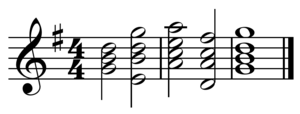



In music, an approach chord (also chromatic approach chord and dominant approach chord) is a chord one half-step higher or lower than the goal, especially in the context of turnarounds and cycle-of-fourths progressions, for example the two bar 50s progression:[3]
|G / Em / |Am / D7 / ||
may be filled in with approach chords:
|G F9 Em A♭m |Am D♯7 D7 G♭7 ||
F9 being the half-step to Em, A♭m being the half-step to Am, D♯7 being the half-step to D7, and G♭7 being the half-step to G. G being I, Em being vi, Am being ii, and D7 being V7 (see ii-V-I turnaround and circle progression).
An approach chord may also be the chord immediately preceding the target chord such as the subdominant (FMaj7) preceding the tonic (CMaj7) creating a strong cadence through the contrast of no more than two common tones:[4] FACE – CEGB.
Approach chords may thus be a semitone or a fifth or fourth from their target.[5]
Approach chords create the harmonic space of the modes in jazz rather than secondary dominants.[6]
See also
References
- ^ Boyd, Bill (1997). Jazz Chord Progressions, p.43. ISBN 0-7935-7038-7.
- ^ Fisher, Jody (2000). Jazz Skills: Filling the Gaps for the Serious Guitarist, p.30. ISBN 1-929395-10-8.
- ^ Sokolow, Fred (2002). Jazzing It Up, p.11. ISBN 0-7935-9112-0.
- ^ Felts, Randy (2002). Reharmonization Techniques, p.19. ISBN 0-634-01585-0.
- ^ Grove, Dick (1989). Arranging Concepts Complete: The Ultimate Arranging Course for Today's Music, p.139. ISBN 0-88284-484-9.
- ^ Pease, Ted (2003). Jazz Composition: Theory and Practice, p.68. ISBN 0-87639-001-7.
Further reading
- R., Ken (2012). DOG EAR Tritone Substitution for Jazz Guitar, Amazon Digital Services, Inc., ASIN: B008FRWNIW









